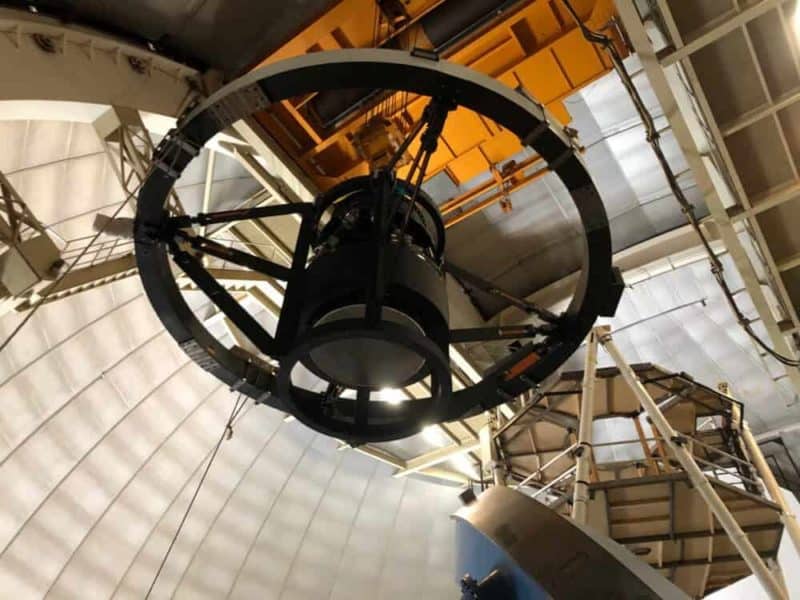In this time-lapse video, crews at the Mayall Telescope near Tucson, Arizona, lift and install the top-end components for the Dark Energy Spectroscopic Instrument, or DESI. The components, which include a stack of six lenses and other structures for positioning and support, weigh about 12 tons. DESI, scheduled to begin its sky survey next year, is designed to produce the largest 3-D map of the universe and produce new clues about the nature of dark energy. (Credit: Robert T. Sparks, NOAO/AURA)
Key components for the sky-mapping Dark Energy Spectroscopic Instrument (DESI), weighing about 12 tons, were hoisted atop the Mayall Telescope at Kitt Peak National Observatory (KPNO) near Tucson, Arizona, and bolted into place Wednesday, marking a major project milestone.
DESI will create the largest 3-D map of the universe by gathering light from tens of millions of galaxies after its scheduled startup in late 2019. It is designed to provide more precise measurements of dark energy, which is accelerating the universe’s expansion and looms as one of the universe’s biggest mysteries.
“Earlier this year we removed the old top-end of the Mayall Telescope, and Wednesday’s installation brings this telescope back to life with a new purpose,” said DESI Director Michael Levi of the Department of Energy’s Lawrence Berkeley National Laboratory (Berkeley Lab), which is leading the project’s international collaboration. “The more than 23,000 pounds of instrumentation that was installed represents the final top-end assembly.”
The new top-end components include a 3.4-ton barrel-shaped, steel-framed structure, known as a corrector, that houses a precisely stacked array of large (the largest is 1.1 meters in diameter), delicate lenses.
Also, the corrector is attached to a 1.1-ton six-axis “hexapod” that enables precise alignment adjustments; a surrounding ring, cage, and vanes support structure that weighs an additional 5.2 tons; and about 2 tons of other materials, including placeholder weights for DESI’s focal plane (see a related video), which is still under assembly and hasn’t yet arrived on site.
A team at Fermi National Accelerator Laboratory built the corrector, hexapod, and other top-end support structures. The structures are designed to align the lenses with an accuracy of tens of microns (millionths of a meter) – similar to the width of the thinnest human hair.
DESI involves more than 450 researchers from more than 70 institutions around the globe. KPNO is part of the National Optical Astronomy Observatory, which is operated by the Association of Universities for Research in Astronomy under a cooperative agreement with the National Science Foundation.
The corrector will enable a larger field of view – covering an area more than 40 times larger than the telescope’s previous corrector, and more than 40 times the size of the full moon as seen from Earth’s surface – for a series of 5,000 robotically positioned fiber-optic cables that will gather light from sequences of targeted galaxies. This light will be analyzed to gather information about their distance and the rate at which the galaxies are moving away from us. Its large field of view will allow DESI to map one-third of the night sky during its planned 5-year survey.
Crews at the Mayall Telescope near Tucson, Arizona, lift and install the top-end components for the Dark Energy Spectroscopic Instrument, or DESI. The components, which include a stack of six lenses and other structures or positioning and support, weigh about 12 tons. DESI, scheduled to begin its sky survey next year, is designed to produce the largest 3-D map of the universe and produce new clues about the nature of dark energy. (Credit: David Sprayberry, NOAO/AURA)
Each of the corrector’s six lenses began as a large, thick piece of glass made by either Corning Glass in New York, Ohara Corp. in Japan, or Schott AG in Germany (see a related video). One of the lenses housed in the corrector is among the largest to ever be fielded on a telescope, noted Berkeley Lab’s David Schlegel, a DESI project scientist. The lenses traveled the world for polishings and coatings at several companies, and were installed and precisely aligned inside the corrector barrel in a basement at the University College London last spring.
The corrector and associated components are raised above their final resting place. (Credit: Robert Besuner/Berkeley Lab, DESI Collaboration)
The corrector was then disassembled for transport and flown on a chartered transport plane from England to Tucson, Arizona. Then, it was trucked to the Kitt Peak summit, at an elevation of 6,800 feet. Once reassembled, the corrector was connected to its mechanical support system.
In June, a 250-foot mobile crane was used to lift the old top-end off of the telescope and out of the dome. A 50-ton crane in the dome of the Mayall Telescope was used to lift all the DESI top-end components up to the dome floor from the ground level, where they were assembled. The same dome crane was then used to lift the assembled DESI top-end into position atop the telescope.
David Sprayberry, the KPNO site director for DESI, said, “This was a complex lift that went without a hitch. We had a dozen of our technical personnel ensuring that the new top-end would be positioned exactly onto the center of the telescope. I’m very proud of my team for pulling this off flawlessly.”
Early next year, researchers will mount a set of cameras and other instruments onto DESI’s focal plane to test how the lenses perform across the entire imaging field. This commissioning camera array was built at Ohio State University.
“This will be a real test to determine if all the lenses are working together perfectly,” said Paul Martini, a professor at Ohio State University who oversaw the development of the commissioning camera.
Then, other DESI systems will be tested over the next several months until the entire instrument is ready to begin its sky survey.
The corrector is lowered onto its telescope mount. (Credit: Robert Besuner/Berkeley Lab, DESI Collaboration)





